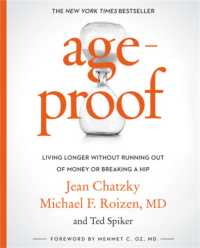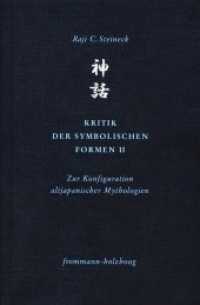Full Description
This book charts the development of style and lexicon in the English language from Late Middle English to Early Modern English through the analysis of binomials across a wide range of texts and genres.
The volume elucidates the forms, functions, and origins of binomials, otherwise understood as word pairs, such as "safe and sound," as they manifest in representative prose texts from the fourteenth and fifteenth centuries and in the Helsinki Corpus from the fourteenth through to the early eighteenth centuries. The book begins with cross-comparative analyses of binomials, examining their frequency, etymological makeup, and repetition in prose texts including Chaucer and Malory to explore the stylistic characteristics of each text, toward zooming out to examine their development in texts across different genres, from political to philosophical to legal texts, in the Helsinki Corpus. In charting binomial development over both time and text type, the volume offers readers a unique historical perspective into the evolution of phraseology from Late Middle English through to Early Modern English and in turn, a solid foundation for future research on lexical development in the English language.
This book will be of interest to scholars in English historical linguistics, English stylistics, English corpus linguistics, and English lexicology.
Chapter 8 of this book is freely available as a downloadable Open Access PDF at http://www.taylorfrancis.com under a Creative Commons Attribution-NonCommercial-NoDerivatives (CC-BY-NC-ND) 4.0 International license.
Contents
Contents
List of Figures
List of Tables
Acknowledgements
Abbreviations
Chapter 1 Introduction
1.1 The purpose of the Present Monograph
1.2 Characteristics of Binomials to be Analyzed in this Study
1.3 Frequency and Distribution of Binomials
1.4 Significance of Studying Binomials in LME prose
1.5 Styles in LME prose
1.6 Lexical Reorganization in LME and its Impact on Phraseology
1.7 Previous Studies of Binomials in LME
1.8 Research Methodology
1.9 LME Texts to be Examined and the Editions and E-texts Employed
1.10 The Structure of this Study
Chapter 2 A Preliminary Survey of Binomials in Chaucer's Prose Texts
2.1 Introduction
2.2 Previous Studies on Chaucer's Prose and on Binomials in Chaucer's Prose
2.3 Normalized Frequency of Binomials in Chaucer's Prose Texts
2.4 Etymological Makeup of Binomials in Chaucer's Prose Texts
2.5 Repetition of Binomials in Chaucer's Prose Texts
2.6 Summary and Conclusion
Chapter 3 Binomials in Caxton's Translations: Paris and Vienne and the History of Reynard the Fox
3.1 Introduction
3.2 Normalized Frequency of Binomials in Paris and Reynard
3.3 Etymological Makeup of Binomials in Paris and Reynard
3.4 Repetition of Binomials in Paris and Reynard
3.5 Caxton vs. Chaucer: A Comparison of Translated Works, Caxton's Paris and
Chaucer's Bo
3.6 Summary and Conclusion
Chapter 4 Binomials in a Chronicle and the "Chronicle Style:" The Brut and Malory's Le Morte Darthur
4.1 Introduction
4.2 Binomials in the Brut or the Chronicle of England
4.3 Binomials in the Works of Sir Thomas Malory
4.4 Book V of Caxton's Edition of Le Morte Darthur vs. Book 2 in the Winchester
Manuscript
4.5 Summary and Conclusion
Chapter 5 Binomials in Political and Philosophical Texts: On the Governance of England and On the Properties of Things
5.1 Binomials in On the Governance of England
5.2 Binomials in On the Properties of Things
5.3 Summary and Conclusion
Chapter 6 Binomials in Religious Texts: The Mirror of the Blessed Life of Jesus Christ and the English Wycliffite Sermons
6.1 Introduction
6.2 Binomials in The Mirror of the Blessed Life of Jesus Christ
6.3 Binomials in the English Wycliffite Sermons
6.4 Comparative Analysis of Religious Texts: The Parson's Tale, The Mirror of the
Blessed Life of Jesus Christ, and the English Wycliffite Sermons
6.5 Summary and Conclusion
Chapter 7 Binomials in Epistolary and Legal Documents: The Signet Letters of Henry V and the Paston Letters and Papers
7.1 Introduction
7.2 Binomials in the Signet Letters of Henry V
7.3 Binomials in the Paston Letters and Papers
7.4 Comparison between the Signet Letters of Henry V and the Paston Letter Texts
7.5 Summary and Conclusion
Chapter 8 Grouping and Comparison of Texts Using Statistical Analyses of Binomials
8.1 Introduction
8.2 Overall Data of Frequency and Etymological Makeup
8.3 Statistical Analyses
8.4 Comparison of Findings by Statistical Analyses with Manual Analyses in the Foregoing Chapters
8.5 Summary and Conclusion
Chapter 9 Motivations for the Use of Binomials (1): Evidences from Chaucer's and Caxton's Translations
9.1 Introduction
9.2 Motivations for the Use of Binomials in Chaucer's Prose Texts
9.3 Caxton's Treatment of Binomials in the History of Reynard the Fox in Comparison with the MD Original Die Historie Van Den Vos Reynaerde
9.4 Caxton's Treatment of Binomials in Paris and Vienne in Comparison to the MF Original Paris et Vienne
9.5 Conclusion
Chapter 10 Motivations for the Use of Binomials (2): Evidences from a Comparison of Binomials Between Chaucer's Verse and Prose
10.1 Motivation for the Use of Binomials in Chaucer's Prose Compared to Binomials in his Verse
10.2 Previous Studies
10.3 Normalized Frequency of Binomials in Chaucer's Verse and Prose
10.4 Etymological Makeup of Binomials in Chaucer's Verse and Prose
10.5 Repetition of Binomials in Chaucer's Verse and Prose
10.6 Morphology of Binomial Members in Chaucer's Verse and Prose
10.7 Rhyming Binomials in Chaucer's Verse
10.8 Binomials in Individual Verse Texts of Fragment I
10.9 Conclusion
Chapter 11 Historical Development of Binomials from 1350 to 1710 across Text Types in the Helsinki Corpus
11.1 Introduction
11.2 Frequency of Binomials
11.3 Etymological Makeup of Binomials
11.4 Relevance of the Most Repeated Binomials to Text Types
11.5 Summary and Conclusion
Chapter 12 Conclusion
References
Index







